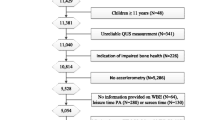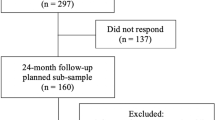Abstract
Introduction
Physical activity (PA) is a key factor of bone mass acquisition in peripubertal children. Sedentary behavior (SB) has been shown to influence bone outcomes. This study aimed to examine the association between objectively measured PA and SB and bone stiffness in Japanese children.
Materials and Methods
Participants were fifth-grade children aged 10–11 years from Project Koshu. The stiffness index (SI) of the calcaneus was measured by quantitative ultrasound; PA and SB were evaluated by an accelerometer. Each PA parameter was divided into sex-specific tertile or stratified by recommended PA guideline [≥ 60 min/day of moderate-to-vigorous PA (MVPA)]. The SI was compared among PA and SB through analysis of covariance with Bonferroni correction.
Results
Of 174 children, complete data were obtained from 134 (60 boys and 74 girls). The SI in boys was higher in the highest tertile of MVPA than that in the other groups. A similar association was found in girls but was not significant. Children who met the PA guideline had higher SI than those who did not, but there was no significant difference. A negative relation was observed in girls, with the SI gradually decreasing along with increasing SB (p for trend = 0.038). This association was not observed among boys.
Conclusion
This study suggests that MVPA is positively associated with bone stiffness in Japanese schoolchildren in boys and SB is negatively associated with that in girls. Reducing SB might be a brief modifiable factor for preventing lower peak bone mass in girls, in addition to increasing MVPA.

Similar content being viewed by others
References
Lazcano-Ponce E, Tamayo J, Cruz-Valdez A, Díaz R, Hernández B, Del Cueto R, Hernández-Avila M (2003) Peak bone mineral area density and determinants among females aged 9 to 24 years in Mexico. Osteoporos Int 14:539–547
Santos L, Elliott-Sale KJ, Sale C (2017) Exercise and bone health across the lifespan. Biogerontology 18:931–946
MacKelvie KJ, Khan KM, McKay HA (2002) Is there a critical period for bone response to weight-bearing exercise in children and adolescents? a systematic review. Br J Sports Med 36:250–257
Marshall D, Johnell O, Wedel H (1996) Meta-analysis of how well measures of bone mineral density predict occurrence of osteoporotic fractures. BMJ 312:1254–1259
Gunter KB, Almstedt HC, Janz KF (2012) Physical activity in childhood may be the key to optimizing lifespan skeletal health. Exerc Sport Sci Rev 40:13–21
Rizzoli R, Bianchi ML, Garabédian M, McKay HA, Moreno LA (2010) Maximizing bone mineral mass gain during growth for the prevention of fractures in the adolescents and the elderly. Bone 46:294–305
Weaver CM, Gordon CM, Janz KF, Kalkwarf HJ, Lappe JM, Lewis R, O’Karma M, Wallace TC, Zemel BS (2016) The National Osteoporosis Foundation’s position statement on peak bone mass development and lifestyle factors: a systematic review and implementation recommendations. Osteoporos Int 27:1281–1386
Tan VP, Macdonald HM, Kim S, Nettlefold L, Gabel L, Ashe MC, McKay HAJ (2014) Influence of physical activity on bone strength in children and adolescents: a systematic review and narrative synthesis. J Bone Miner Res 10:2161–2181
Nikander R, Sievänen H, Heinonen A, Daly RM, Uusi-Rasi K, Kannus P (2010) Targeted exercise against osteoporosis: a systematic review and meta-analysis for optimising bone strength throughout life. BMC Med 8:47
World Health Organization (2017) Physical activity fact sheet. http://www.who.int/mediacentre/factsheets/fs385/en/. Accessed 1 Apr 2019
World Health Organization (2010) Global recommendations: physical activity for health. http://www.who.int/dietphysicalactivity/publications/9789241599979/en/. Accessed 1 Apr 2019
The Japan Sports Agency (2018) The report of FY2018 national survey on physical fitness, athletic performance and exercise habits. http://www.mext.go.jp/sports/b_menu/toukei/kodomo/zencyo/1411922.htm. Accessed 23 Apr 2019 (in Japanese)
The Japan Pediatric Association (2004) Proposal for children’s media use. https://www.jpa-web.org/dcms_media/other/ktmedia_teigenzenbun.pdf. Accessed 23 Apr 2019 (in Japanese)
Patterson R, McNamara E, Tainio M, de Sá TH, Smith AD, Sharp SJ, Edwards P, Woodcock J, Brage S, Wijndaele K (2018) Sedentary behaviour and risk of all-cause, cardiovascular and cancer mortality, and incident type 2 diabetes: a systematic review and dose response meta-analysis. Eur J Epidemiol 33:811–829
Biswas A, Oh PI, Faulkner GE, Bajaj RR, Silver MA, Mitchell MS, Alter DA (2015) Sedentary time and its association with risk for disease incidence, mortality, and hospitalization in adults: a systematic review and meta-analysis. Ann Intern Med 162:123–132
Tremblay MS, LeBlanc AG, Kho ME, Saunders TJ, Larouche R, Colley RC, Goldfield G, Connor Gorber S (2011) Systematic review of sedentary behaviour and health indicators in school-aged children and youth. Int J Behav Nutr Phys Act 8:98
Tremblay MS, Colley RC, Saunders TJ, Healy GN, Owen N (2010) Physiological and health implications of a sedentary lifestyle. Appl Physiol Nutr Metab 35:725–740
Koedijk JB, van Rijswijk J, Oranje WA, van den Bergh JP, Bours SP, Savelberg HH, Schaper NC (2017) Sedentary behaviour and bone health in children, adolescents and young adults: a systematic review. Osteoporos Int 28:2507–2519
Xu Y, Guo B, Gong J, Xu H, Bai Z (2014) The correlation between calcaneus stiffness index calculated by QUS and total body BMD assessed by DXA in Chinese children and adolescents. J Bone Miner Metab 32:159–166
Babatunde OO, Forsyth JJ (2013) Quantitative ultrasound and bone’s response to exercise: a meta analysis. Bone 53:311–318
Suzuki K (2015) Longitudinal analyses of childhood growth: evidence from Project Koshu. J Epidemiol 25:2–7
McClain JJ, Sisson SB, Washington TL, Craig CL, Tudor-Locke C (2007) Comparison of Kenz Lifecorder EX and ActiGraph accelerometers in 10-yr-old children. Med Sci Sports Exerc 39:630–638
Kumahara H, Schutz Y, Ayabe M, Yoshioka M, Yoshitake Y, Shindo M, Ishii K, Tanaka H (2004) The use of uniaxial accelerometry for the assessment of physical activity-related energy expenditure: a validation study against whole-body indirect calorimetry. Br J Nutr 91:235–243
Arabi A, Nabulsi M, Maalouf J, Choucair M, Khalifé H, Vieth R, El-Hajj Fuleihan G (2004) Bone mineral density by age, gender, pubertal stages, and socioeconomic status in healthy Lebanese children and adolescents. Bone 35:1169–1179
Ishii M, Uenishi K, Ishida H, Kushima Y (2005) Development of the “self-assessment table for calcium intake” and evaluation of its validity. Osteoporos Jpn 13:497–502 (in Japanese)
Miyoshi M, Tsuboyama-Kasaoka N, Nishi N (2012) School-based “Shokuiku” program in Japan: application to nutrition education in Asian countries. Asia Pac J Clin Nutr 21:159–162
Currie C, Molcho M, Boyce W, Holstein B, Torsheim T, Richter M (2008) Researching health inequalities in adolescents: the development of the health behaviour in school-aged children (HBSC) family affluence scale. Soc Sci Med 66:1429–1436
Oh IH, Cho Y, Park SY, Oh C, Choe BK, Choi JM, Yoon TY (2011) Relationship between socioeconomic variables and obesity in Korean adolescents. J Epidemiol 21:263–270
Elgar FJ, Pförtner TK, Moor I, De Clercq B, Stevens GW, Currie C (2015) Socioeconomic inequalities in adolescent health 2002–2010: a time-series analysis of 34 countries participating in the health behaviour in school-aged children study. Lancet 385:2088–2095
Nogueira RC, Weeks BK, Beck BR (2014) Exercise to improve pediatric bone and fat: a systematic review and meta-analysis. Med Sci Sports Exerc 46:610–621
Zymbal V, Baptista F, Letuchy EM, Janz KF, Levy SM (2019) Mediating effect of muscle on the relationship of physical activity and bone. Med Sci Sports Exerc 51:202–210
Osborn W, Simm P, Olds T, Lycett K, Mensah FK, Muller J, Fraysse F, Ismail N, Vlok J, Burgner D, Carlin JB, Edwards B, Dwyer T, Azzopardi P, Ranganathan S, Wake M (2018) Bone health, activity and sedentariness at age 11–12 years: cross-sectional Australian population-derived study. Bone 112:153–160
Gabel L, Macdonald HM, Nettlefold LA, McKay HA (2018) Sex-, ethnic-, and age-specific centile curves for pQCT- and HR-pQCT-derived measures of bone structure and strength in adolescents and young adults. J Bone Miner Res 33:987–1000
Ivuškāns A, Mäestu J, Jürimäe T, Lätt E, Purge P, Saar M, Maasalu K, Jürimäe J (2015) Sedentary time has a negative influence on bone mineral parameters in peripubertal boys: a 1-year prospective study. J Bone Miner Metab 33:85–92
Janz KF, Letuchy EM, Burns TL, Eichenberger Gilmore JM, Torner JC, Levy SM (2014) Objectively measured physical activity trajectories predict adolescent bone strength: Iowa Bone Development Study. Br J Sports Med 48:1032–1036
Chastin SF, Mandrichenko O, Skelton DA (2014) The frequency of osteogenic activities and the pattern of intermittence between periods of physical activity and sedentary behaviour affects bone mineral content: the cross-sectional NHANES study. BMC Public Health 6:4
Vaitkeviciute D, Lätt E, Mäestu J, Jürimäe T, Saar M, Purge P, Maasalu K, Jürimäe J (2014) Physical activity and bone mineral accrual in boys with different body mass parameters during puberty: a longitudinal study. PLoS One 9:e107759
Heidemann M, Mølgaard C, Husby S, Schou AJ, Klakk H, Møller NC, Holst R, Wedderkopp N (2013) The intensity of physical activity influences bone mineral accrual in childhood: the childhood health, activity and motor performance school (the CHAMPS) study, Denmark. BMC Pediatr 2:32
Herrmann D, Buck C, Sioen I, Kouride Y, Marild S, Molnár D, Mouratidou T, Pitsiladis Y, Russo P, Veidebaum T, Ahrens W, IDEFICS consortium (2015) Impact of physical activity, sedentary behaviour and muscle strength on bone stiffness in 2-10-year-old children-cross-sectional results from the IDEFICS study. Int J Behav Nutr Phys Act 17:112
Herrmann D, Pohlabeln H, Gianfagna F, Konstabel K, Lissner L, Mårild S, Molnar D, Moreno LA, Siani A, Sioen I, Veidebaum T, Ahrens W, IDEFICS Consortium (2015) Association between bone stiffness and nutritional biomarkers combined with weight-bearing exercise, physical activity, and sedentary time in preadolescent children. A case–control study. Bone 78:142–149
De Smet S, Michels N, Polfliet C, D’Haese S, Roggen I, De Henauw S, Sioen I (2015) The influence of dairy consumption and physical activity on ultrasound bone measurements in Flemish children. J Bone Miner Metab 33:192–200
Sayers A, Mattocks C, Deere K, Ness A, Riddoch C, Tobias JH (2011) Habitual levels of vigorous, but not moderate or light, physical activity is positively related to cortical bone mass in adolescents. J Clin Endocrinol Metab 96:E793–E802
Sardinha LB, Baptista F, Ekelund U (2008) Objectively measured physical activity and bone strength in 9-year-old boys and girls. Pediatrics 122:e728–e736
Gracia-Marco L, Moreno LA, Ortega FB, León F, Sioen I et al (2011) Levels of physical activity that predict optimal bone mass in adolescents: the HELENA study. Am J Prev Med 40:599–607
Thomsen K, Jepsen DB, Matzen L, Hermann AP, Masud T, Ryg J (2015) Is calcaneal quantitative ultrasound useful as prescreen stratification tool for osteoporosis? Osteoporos Int 26:1459–1475
Wang KC, Wang KC, Amirabadi A, Cheung E, Uleryk E, Moineddin R, Doria AS (2014) Evidence-based outcomes on diagnostic accuracy of quantitative ultrasound for assessment of pediatric osteoporosis—a systematic review. Pediatr Radiol 44:1573–1587
Moayyeri A, Adams JE, Adler RA, Krieg MA, Hans D, Compston J, Lewiecki EM (2012) Quantitative ultrasound of the heel and fracture risk assessment: an updated meta-analysis. Osteoporos Int 23:143–153
Tanner JM, Whitehouse RH (1976) Clinical longitudinal standards for height, weight, height velocity, weight velocity, and stages of puberty. Arch Dis Child 51:170–179
Acknowledgements
We thank the study participants for the use of their personal data. We also thank the principal, vice principal, and homeroom teachers at the elementary schools. We are extremely grateful to the school nurses of each school for their support. This study was supported by JSPS KAKENHI (Grant numbers 26750335, 17K01794, 15K08801, 24590788, 23390173, 18H03037, 18K10064, and 18K17375) and Kitasato University Research Grant for Young Researchers.
Author information
Authors and Affiliations
Contributions
Study design: MY, DA, MS, and ZY. Study conduct and data collection: MY, DA, YA, MS, and KS. Data analysis: MY and AY. Data interpretation and drafting manuscript: all authors. MY and AY take responsibility for the integrity of the data analysis. All authors read, revised, and approved the final manuscript.
Corresponding author
Ethics declarations
Conflict of interest
All authors have no conflicts of interest.
Additional information
Publisher's Note
Springer Nature remains neutral with regard to jurisdictional claims in published maps and institutional affiliations.
Electronic supplementary material
Below is the link to the electronic supplementary material.
About this article
Cite this article
Yamakita, M., Ando, D., Akiyama, Y. et al. Association of objectively measured physical activity and sedentary behavior with bone stiffness in peripubertal children. J Bone Miner Metab 37, 1095–1103 (2019). https://doi.org/10.1007/s00774-019-01021-z
Received:
Accepted:
Published:
Issue Date:
DOI: https://doi.org/10.1007/s00774-019-01021-z




